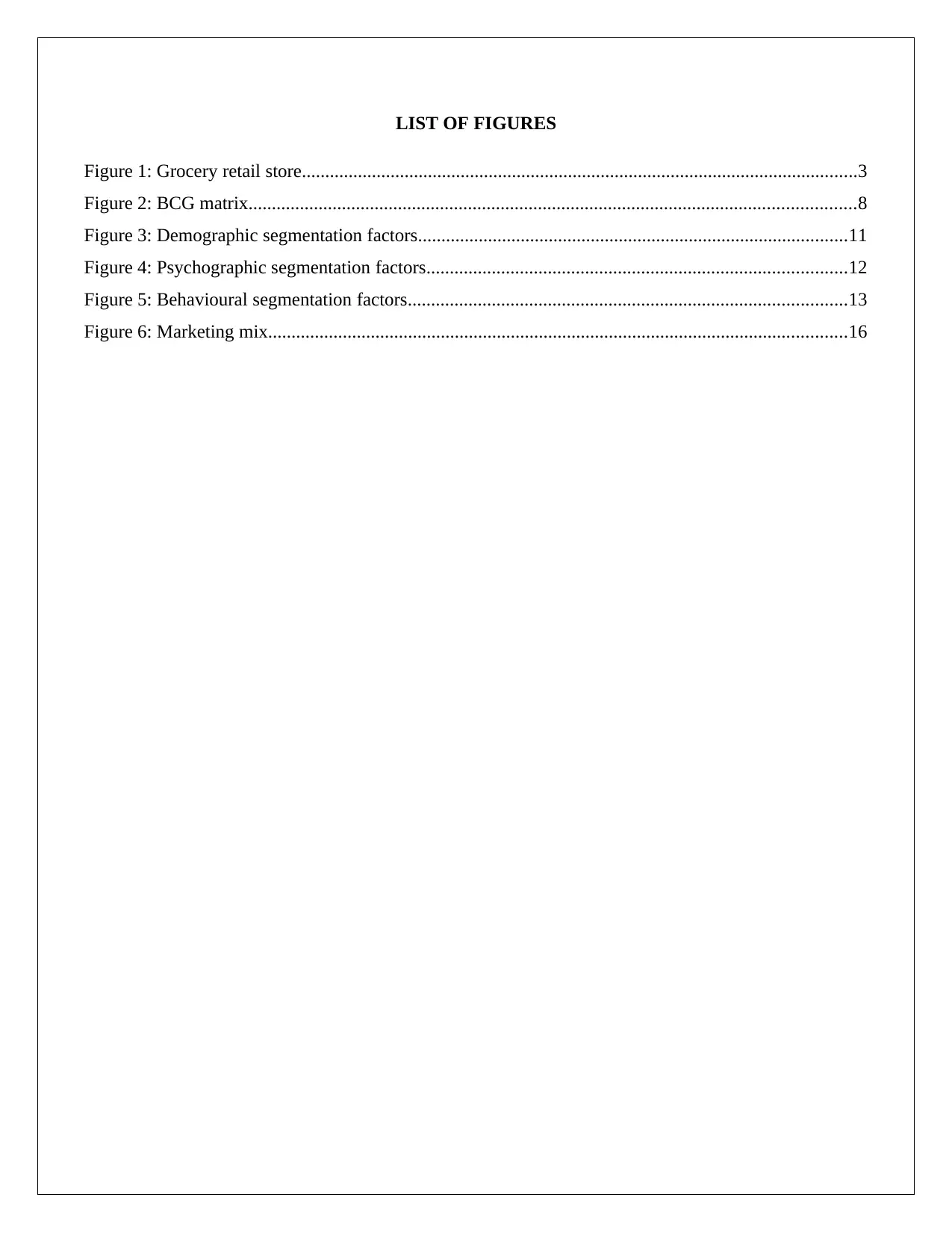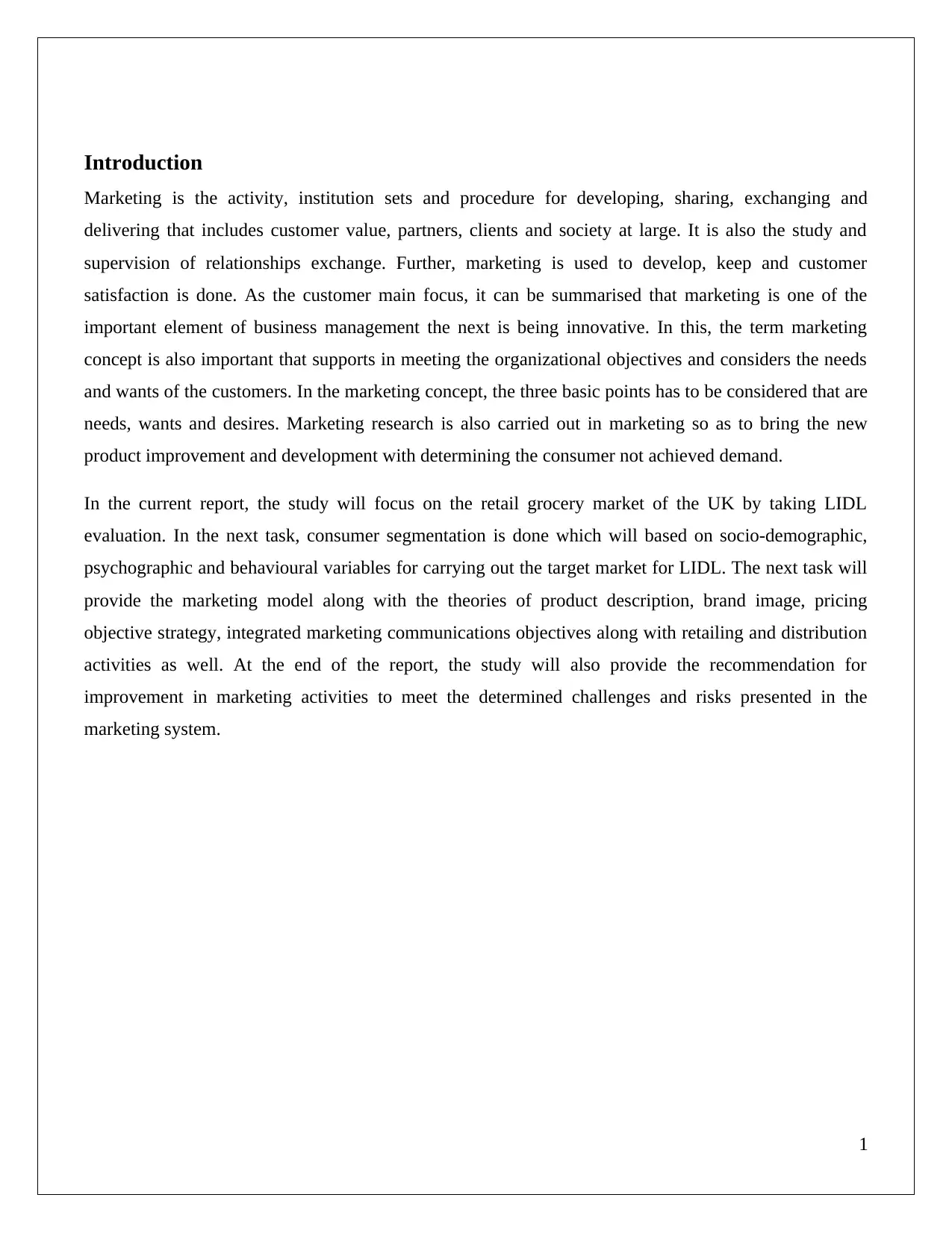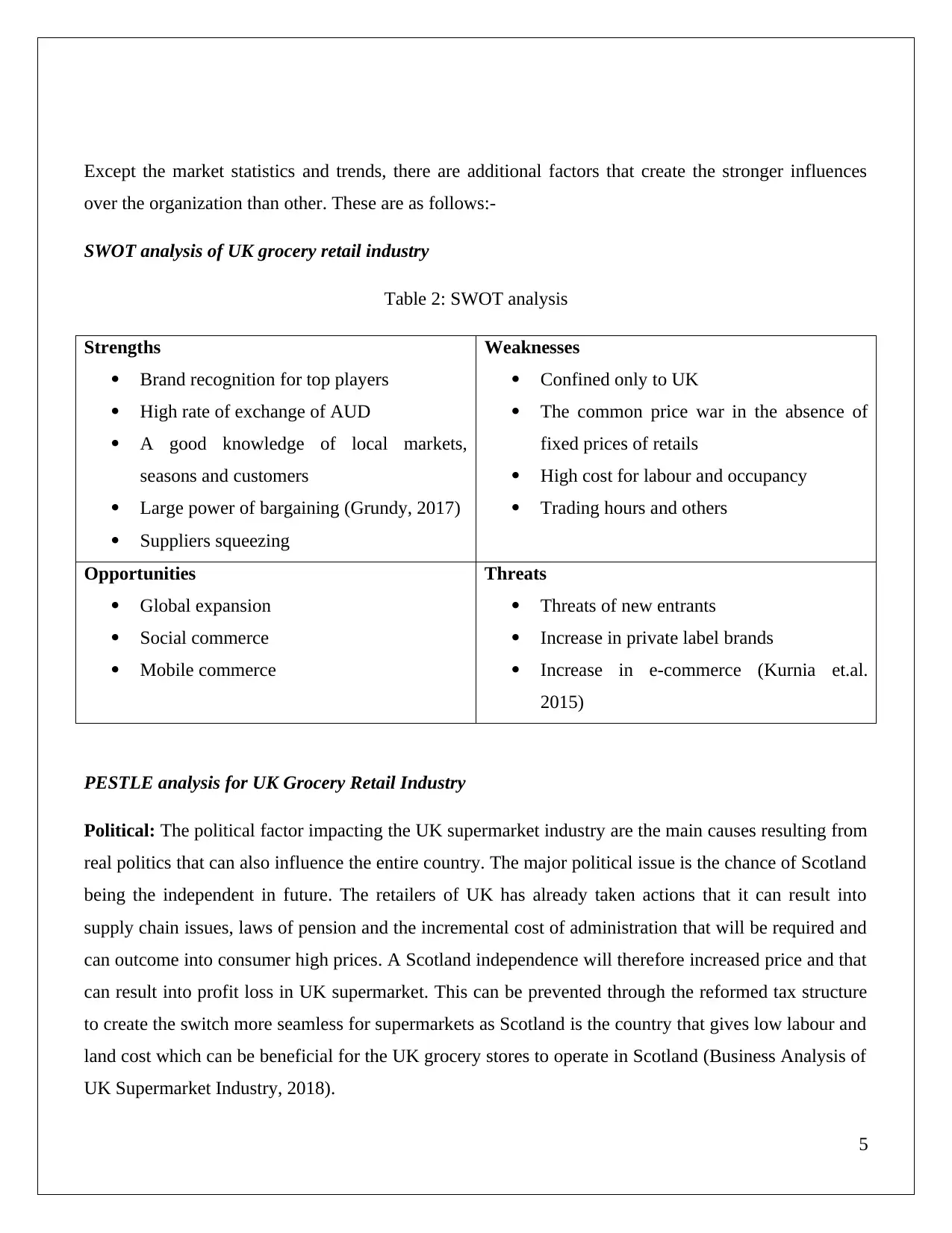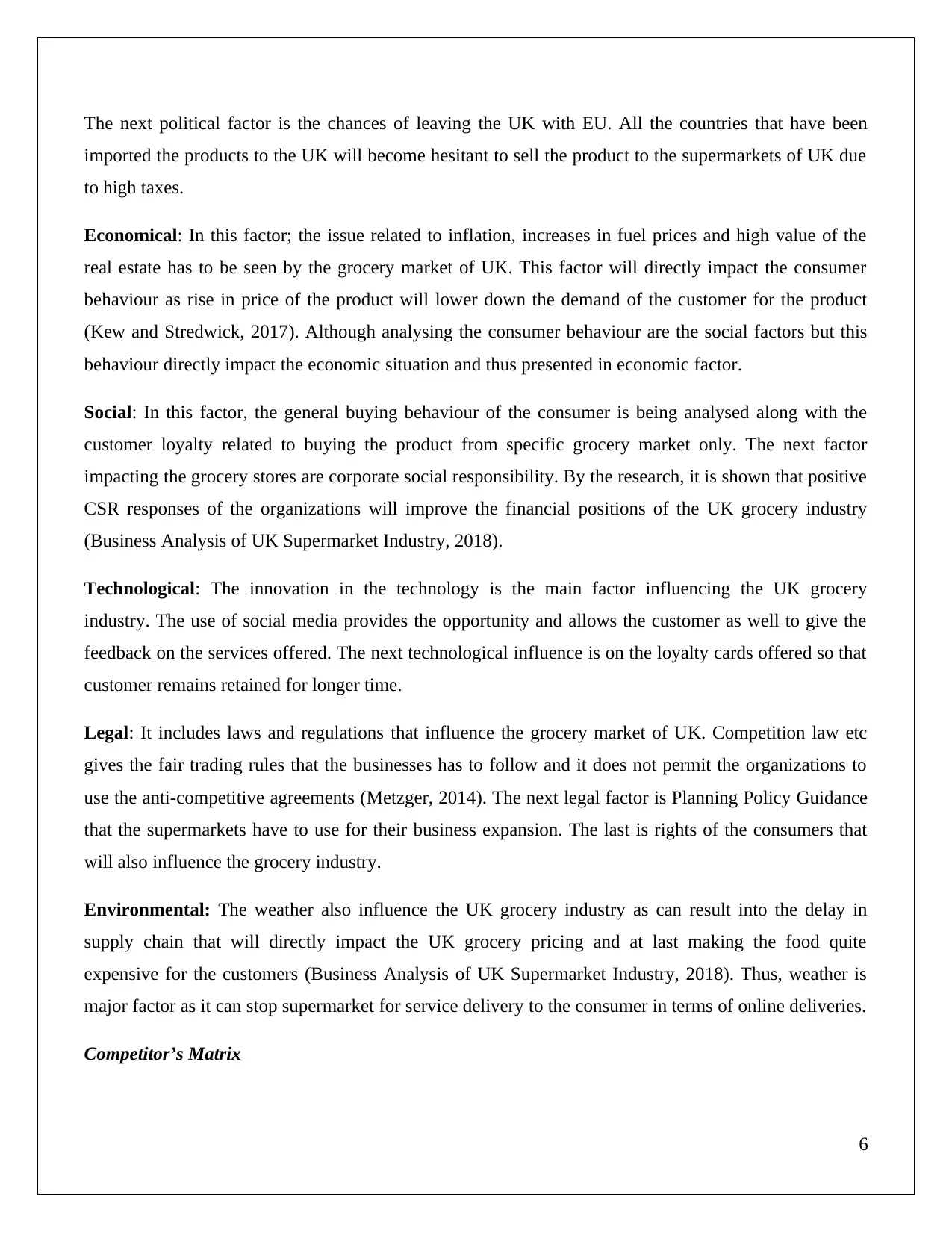Strategic Marketing for LIDL: Analysis of UK Grocery Retail Market
VerifiedAdded on 2024/06/04
|29
|6876
|132
Report
AI Summary
This report provides a comprehensive analysis of the UK grocery retail market with a specific focus on LIDL's marketing strategy. It includes market research, consumer segmentation based on socio-demographic, psychographic, and behavioral variables, and a detailed 7 P's marketing mix model tailored for LIDL's target market. The report also features a SWOT and PESTLE analysis of the UK grocery retail industry, a competitor's matrix comparing LIDL to other major players like Tesco and Sainsbury, and recommendations for addressing challenges and risks in the marketing system. The executive summary highlights LIDL's brand quality, product offerings, pricing strategy, website improvements, and competitive entry restrictions.

INTRODUCTION TO MARKETING
Paraphrase This Document
Need a fresh take? Get an instant paraphrase of this document with our AI Paraphraser

EXECUTIVE SUMMARY
Marketing in the business is the important technique that supports in bringing more revenue to the
businesses. The report marketing include marketing strategy, models, concepts, key components that are
important for the business sustainability and managing market share. The LIDL is the organization that
is been making efforts to move as quickly as possible to reach till the competitors like Tesco, Sainsbury
and Morrisons. The key result of the summary is brand quality product offering with reasonable pricing,
improvement in official websites of LIDL and restricting the new entry so market share did not reduce.
Marketing in the business is the important technique that supports in bringing more revenue to the
businesses. The report marketing include marketing strategy, models, concepts, key components that are
important for the business sustainability and managing market share. The LIDL is the organization that
is been making efforts to move as quickly as possible to reach till the competitors like Tesco, Sainsbury
and Morrisons. The key result of the summary is brand quality product offering with reasonable pricing,
improvement in official websites of LIDL and restricting the new entry so market share did not reduce.

TABLE OF CONTENTS
Introduction..................................................................................................................................................1
Task 1...........................................................................................................................................................2
Conduct the market research on the current UK grocery retail market...................................................2
Task 2.........................................................................................................................................................10
Conduct research on the UK population to determine which segments will provide “Lidl” Company
with a higher yield of consumers...........................................................................................................10
Task 3.........................................................................................................................................................16
Proposed market plan develop a detailed 7 P’s Marketing Mix Model to target the identified segment
covering.................................................................................................................................................16
Recommendations in tackling the challenges and risks........................................................................19
Conclusion.................................................................................................................................................21
References..................................................................................................................................................22
Introduction..................................................................................................................................................1
Task 1...........................................................................................................................................................2
Conduct the market research on the current UK grocery retail market...................................................2
Task 2.........................................................................................................................................................10
Conduct research on the UK population to determine which segments will provide “Lidl” Company
with a higher yield of consumers...........................................................................................................10
Task 3.........................................................................................................................................................16
Proposed market plan develop a detailed 7 P’s Marketing Mix Model to target the identified segment
covering.................................................................................................................................................16
Recommendations in tackling the challenges and risks........................................................................19
Conclusion.................................................................................................................................................21
References..................................................................................................................................................22
⊘ This is a preview!⊘
Do you want full access?
Subscribe today to unlock all pages.

Trusted by 1+ million students worldwide

LIST OF FIGURES
Figure 1: Grocery retail store.......................................................................................................................3
Figure 2: BCG matrix..................................................................................................................................8
Figure 3: Demographic segmentation factors............................................................................................11
Figure 4: Psychographic segmentation factors..........................................................................................12
Figure 5: Behavioural segmentation factors..............................................................................................13
Figure 6: Marketing mix............................................................................................................................16
Figure 1: Grocery retail store.......................................................................................................................3
Figure 2: BCG matrix..................................................................................................................................8
Figure 3: Demographic segmentation factors............................................................................................11
Figure 4: Psychographic segmentation factors..........................................................................................12
Figure 5: Behavioural segmentation factors..............................................................................................13
Figure 6: Marketing mix............................................................................................................................16
Paraphrase This Document
Need a fresh take? Get an instant paraphrase of this document with our AI Paraphraser

LIST OF TABLES
Table 1: Market share of different UK supermarket chain..........................................................................4
Table 2: SWOT analysis..............................................................................................................................5
Table 3: Competitors matrix........................................................................................................................7
Table 1: Market share of different UK supermarket chain..........................................................................4
Table 2: SWOT analysis..............................................................................................................................5
Table 3: Competitors matrix........................................................................................................................7

Introduction
Marketing is the activity, institution sets and procedure for developing, sharing, exchanging and
delivering that includes customer value, partners, clients and society at large. It is also the study and
supervision of relationships exchange. Further, marketing is used to develop, keep and customer
satisfaction is done. As the customer main focus, it can be summarised that marketing is one of the
important element of business management the next is being innovative. In this, the term marketing
concept is also important that supports in meeting the organizational objectives and considers the needs
and wants of the customers. In the marketing concept, the three basic points has to be considered that are
needs, wants and desires. Marketing research is also carried out in marketing so as to bring the new
product improvement and development with determining the consumer not achieved demand.
In the current report, the study will focus on the retail grocery market of the UK by taking LIDL
evaluation. In the next task, consumer segmentation is done which will based on socio-demographic,
psychographic and behavioural variables for carrying out the target market for LIDL. The next task will
provide the marketing model along with the theories of product description, brand image, pricing
objective strategy, integrated marketing communications objectives along with retailing and distribution
activities as well. At the end of the report, the study will also provide the recommendation for
improvement in marketing activities to meet the determined challenges and risks presented in the
marketing system.
1
Marketing is the activity, institution sets and procedure for developing, sharing, exchanging and
delivering that includes customer value, partners, clients and society at large. It is also the study and
supervision of relationships exchange. Further, marketing is used to develop, keep and customer
satisfaction is done. As the customer main focus, it can be summarised that marketing is one of the
important element of business management the next is being innovative. In this, the term marketing
concept is also important that supports in meeting the organizational objectives and considers the needs
and wants of the customers. In the marketing concept, the three basic points has to be considered that are
needs, wants and desires. Marketing research is also carried out in marketing so as to bring the new
product improvement and development with determining the consumer not achieved demand.
In the current report, the study will focus on the retail grocery market of the UK by taking LIDL
evaluation. In the next task, consumer segmentation is done which will based on socio-demographic,
psychographic and behavioural variables for carrying out the target market for LIDL. The next task will
provide the marketing model along with the theories of product description, brand image, pricing
objective strategy, integrated marketing communications objectives along with retailing and distribution
activities as well. At the end of the report, the study will also provide the recommendation for
improvement in marketing activities to meet the determined challenges and risks presented in the
marketing system.
1
⊘ This is a preview!⊘
Do you want full access?
Subscribe today to unlock all pages.

Trusted by 1+ million students worldwide

Task 1
Conduct the market research on the current UK grocery retail market
Market research supports the organizations to know about the current opportunities and threats along
with the taste and preferences of the customers. The marketing manager and team can collect the
information about the current trends, statistics, SWOT, PESTLE, competitor’s matrix, BCG and Ansoff
matrix for the UK retail industry (Sheth and Sisodia, 2015). The market research can be done from both
the resources that are primary and secondary research. The primary research will be done through
collecting the real information and statistics by going live into the UK market while secondary is simple
and consumes less time as compare to the primary market research. In secondary market research, the
information is collected through online journals, books and articles. The below market research includes
the following points such as:-
Overview of the UK retail grocery market
The UK grocery sector is the most primitive market around the world. The four leading chains in
supermarket fight fiercely in search of customers with the growing fame for the discount chain. Thus the
grocery sectors consistently document the strongest growth in UK moved by latest and advance grocery
retailers. Convenience stores, online grocery retailing and discounts are the latest formats that are
showing the strong global expansion. Till 2020, the entire value of the grocery market UK will grow
from 9.9% to 196.9 billion pound. In the next five years, the online shopping on account of grocery will
raise to 68%. The food prices in UK have been lowered down due to the fact on competition and
discounts (Hood et.al. 2016).
Further in the last few years, the UK has seen an outstanding shift is that how the customers buy’s the
products by the discounters and online which is ruling in the market. In 2016, ALDI introduced the
“Special Buys” and “wine online” and in UK the Amazon Fresh was also launched.
Current trends and statistics
The UK grocery market was valued at $239.8 billion in 2017 June. It is the enhancement in the 0.3%
from 2016 and grocery stands for 9% of the entire spending of the household in UK which makes third
2
Conduct the market research on the current UK grocery retail market
Market research supports the organizations to know about the current opportunities and threats along
with the taste and preferences of the customers. The marketing manager and team can collect the
information about the current trends, statistics, SWOT, PESTLE, competitor’s matrix, BCG and Ansoff
matrix for the UK retail industry (Sheth and Sisodia, 2015). The market research can be done from both
the resources that are primary and secondary research. The primary research will be done through
collecting the real information and statistics by going live into the UK market while secondary is simple
and consumes less time as compare to the primary market research. In secondary market research, the
information is collected through online journals, books and articles. The below market research includes
the following points such as:-
Overview of the UK retail grocery market
The UK grocery sector is the most primitive market around the world. The four leading chains in
supermarket fight fiercely in search of customers with the growing fame for the discount chain. Thus the
grocery sectors consistently document the strongest growth in UK moved by latest and advance grocery
retailers. Convenience stores, online grocery retailing and discounts are the latest formats that are
showing the strong global expansion. Till 2020, the entire value of the grocery market UK will grow
from 9.9% to 196.9 billion pound. In the next five years, the online shopping on account of grocery will
raise to 68%. The food prices in UK have been lowered down due to the fact on competition and
discounts (Hood et.al. 2016).
Further in the last few years, the UK has seen an outstanding shift is that how the customers buy’s the
products by the discounters and online which is ruling in the market. In 2016, ALDI introduced the
“Special Buys” and “wine online” and in UK the Amazon Fresh was also launched.
Current trends and statistics
The UK grocery market was valued at $239.8 billion in 2017 June. It is the enhancement in the 0.3%
from 2016 and grocery stands for 9% of the entire spending of the household in UK which makes third
2
Paraphrase This Document
Need a fresh take? Get an instant paraphrase of this document with our AI Paraphraser

greatest area of expenditure after housing and transport. There are total 87141 grocery stores of the UK
and it is divided into four sectors:-
Supermarket chains: The main sales area of supermarkets is 3000-25000 square feet and sells the big
range of items of grocery. Superstores are means as the store that includes area above 25000 square feet
that sells the big range of grocery and non food product.
Convenience stores: less than 3000 sq ft area and remain open for longer duration and sale out the
products for minimum eight different grocery categories (Tomczak et.al. 2018).
Traditional retail and developing convenience stores: It also has less than 3000 sq ft and involves green
grocers, stores of liquor, gas stations and new stands.
Alternative channels: It involves big range of outlets such as catalogue home, shopping, internet, market
for farmers and other produce.
Grocery retail structure
Figure 1: Grocery retail store
(Source: UK grocery retail stores, 2018)
3
and it is divided into four sectors:-
Supermarket chains: The main sales area of supermarkets is 3000-25000 square feet and sells the big
range of items of grocery. Superstores are means as the store that includes area above 25000 square feet
that sells the big range of grocery and non food product.
Convenience stores: less than 3000 sq ft area and remain open for longer duration and sale out the
products for minimum eight different grocery categories (Tomczak et.al. 2018).
Traditional retail and developing convenience stores: It also has less than 3000 sq ft and involves green
grocers, stores of liquor, gas stations and new stands.
Alternative channels: It involves big range of outlets such as catalogue home, shopping, internet, market
for farmers and other produce.
Grocery retail structure
Figure 1: Grocery retail store
(Source: UK grocery retail stores, 2018)
3

After identifying the structure of UK grocery store, the next is to identify the major market segments
that includes supermarket chains, discounters, and internet or online shopping, click and collect
convenience store and many more. In UK around four supermarket chains dominate the UK food
retailing which accounts around 70%. The first is the Tesco stands at 28% market share, next is
Sainsbury with 16% market share, then ASDA with 15% market share and last Morrisons 11% market
share. In addition, there are other supermarket chains that include The Coop, Aldi, Lidl, Iceland and
Waitrose (Babin and Zikmund, 2015).
The ALDI and LIDL discounters continue to meet the market share and in last 12 weeks of the 5
November 2017, it reaches to 11.8% for the first time of the grocery market of British. The statistics also
reflected that four in five shoppers said that they visit to discount stores in past month. It also been
shown that around 77% of the households with revenue above 50000 pound consistently buy from
retailers that are budgeted as in comparison with the 73% of the customers that makes 15000 pound or
less as per the market research. One of the major reasons is quality that reflects that 66% of the discount
shoppers said that the premium ranges are just as better as in superior outlets.
The market share of the UK’s supermarkets chains is shown in the table below:-
Table 1: Market share of different UK supermarket chain
Retailers UK market share (%)
Tesco 28.0
Sainsbury 16.2
ASDA’ Wal-Mart 15.3
Morrisons 10.4
ALDI 6.7
The Coop 6.1
Waitrose 5.3
LIDL 5.1
Iceland 2.0
Others 1.7
Symbols and Independents 1.8
Ocado 1.3
4
that includes supermarket chains, discounters, and internet or online shopping, click and collect
convenience store and many more. In UK around four supermarket chains dominate the UK food
retailing which accounts around 70%. The first is the Tesco stands at 28% market share, next is
Sainsbury with 16% market share, then ASDA with 15% market share and last Morrisons 11% market
share. In addition, there are other supermarket chains that include The Coop, Aldi, Lidl, Iceland and
Waitrose (Babin and Zikmund, 2015).
The ALDI and LIDL discounters continue to meet the market share and in last 12 weeks of the 5
November 2017, it reaches to 11.8% for the first time of the grocery market of British. The statistics also
reflected that four in five shoppers said that they visit to discount stores in past month. It also been
shown that around 77% of the households with revenue above 50000 pound consistently buy from
retailers that are budgeted as in comparison with the 73% of the customers that makes 15000 pound or
less as per the market research. One of the major reasons is quality that reflects that 66% of the discount
shoppers said that the premium ranges are just as better as in superior outlets.
The market share of the UK’s supermarkets chains is shown in the table below:-
Table 1: Market share of different UK supermarket chain
Retailers UK market share (%)
Tesco 28.0
Sainsbury 16.2
ASDA’ Wal-Mart 15.3
Morrisons 10.4
ALDI 6.7
The Coop 6.1
Waitrose 5.3
LIDL 5.1
Iceland 2.0
Others 1.7
Symbols and Independents 1.8
Ocado 1.3
4
⊘ This is a preview!⊘
Do you want full access?
Subscribe today to unlock all pages.

Trusted by 1+ million students worldwide

Except the market statistics and trends, there are additional factors that create the stronger influences
over the organization than other. These are as follows:-
SWOT analysis of UK grocery retail industry
Table 2: SWOT analysis
Strengths
Brand recognition for top players
High rate of exchange of AUD
A good knowledge of local markets,
seasons and customers
Large power of bargaining (Grundy, 2017)
Suppliers squeezing
Weaknesses
Confined only to UK
The common price war in the absence of
fixed prices of retails
High cost for labour and occupancy
Trading hours and others
Opportunities
Global expansion
Social commerce
Mobile commerce
Threats
Threats of new entrants
Increase in private label brands
Increase in e-commerce (Kurnia et.al.
2015)
PESTLE analysis for UK Grocery Retail Industry
Political: The political factor impacting the UK supermarket industry are the main causes resulting from
real politics that can also influence the entire country. The major political issue is the chance of Scotland
being the independent in future. The retailers of UK has already taken actions that it can result into
supply chain issues, laws of pension and the incremental cost of administration that will be required and
can outcome into consumer high prices. A Scotland independence will therefore increased price and that
can result into profit loss in UK supermarket. This can be prevented through the reformed tax structure
to create the switch more seamless for supermarkets as Scotland is the country that gives low labour and
land cost which can be beneficial for the UK grocery stores to operate in Scotland (Business Analysis of
UK Supermarket Industry, 2018).
5
over the organization than other. These are as follows:-
SWOT analysis of UK grocery retail industry
Table 2: SWOT analysis
Strengths
Brand recognition for top players
High rate of exchange of AUD
A good knowledge of local markets,
seasons and customers
Large power of bargaining (Grundy, 2017)
Suppliers squeezing
Weaknesses
Confined only to UK
The common price war in the absence of
fixed prices of retails
High cost for labour and occupancy
Trading hours and others
Opportunities
Global expansion
Social commerce
Mobile commerce
Threats
Threats of new entrants
Increase in private label brands
Increase in e-commerce (Kurnia et.al.
2015)
PESTLE analysis for UK Grocery Retail Industry
Political: The political factor impacting the UK supermarket industry are the main causes resulting from
real politics that can also influence the entire country. The major political issue is the chance of Scotland
being the independent in future. The retailers of UK has already taken actions that it can result into
supply chain issues, laws of pension and the incremental cost of administration that will be required and
can outcome into consumer high prices. A Scotland independence will therefore increased price and that
can result into profit loss in UK supermarket. This can be prevented through the reformed tax structure
to create the switch more seamless for supermarkets as Scotland is the country that gives low labour and
land cost which can be beneficial for the UK grocery stores to operate in Scotland (Business Analysis of
UK Supermarket Industry, 2018).
5
Paraphrase This Document
Need a fresh take? Get an instant paraphrase of this document with our AI Paraphraser

The next political factor is the chances of leaving the UK with EU. All the countries that have been
imported the products to the UK will become hesitant to sell the product to the supermarkets of UK due
to high taxes.
Economical: In this factor; the issue related to inflation, increases in fuel prices and high value of the
real estate has to be seen by the grocery market of UK. This factor will directly impact the consumer
behaviour as rise in price of the product will lower down the demand of the customer for the product
(Kew and Stredwick, 2017). Although analysing the consumer behaviour are the social factors but this
behaviour directly impact the economic situation and thus presented in economic factor.
Social: In this factor, the general buying behaviour of the consumer is being analysed along with the
customer loyalty related to buying the product from specific grocery market only. The next factor
impacting the grocery stores are corporate social responsibility. By the research, it is shown that positive
CSR responses of the organizations will improve the financial positions of the UK grocery industry
(Business Analysis of UK Supermarket Industry, 2018).
Technological: The innovation in the technology is the main factor influencing the UK grocery
industry. The use of social media provides the opportunity and allows the customer as well to give the
feedback on the services offered. The next technological influence is on the loyalty cards offered so that
customer remains retained for longer time.
Legal: It includes laws and regulations that influence the grocery market of UK. Competition law etc
gives the fair trading rules that the businesses has to follow and it does not permit the organizations to
use the anti-competitive agreements (Metzger, 2014). The next legal factor is Planning Policy Guidance
that the supermarkets have to use for their business expansion. The last is rights of the consumers that
will also influence the grocery industry.
Environmental: The weather also influence the UK grocery industry as can result into the delay in
supply chain that will directly impact the UK grocery pricing and at last making the food quite
expensive for the customers (Business Analysis of UK Supermarket Industry, 2018). Thus, weather is
major factor as it can stop supermarket for service delivery to the consumer in terms of online deliveries.
Competitor’s Matrix
6
imported the products to the UK will become hesitant to sell the product to the supermarkets of UK due
to high taxes.
Economical: In this factor; the issue related to inflation, increases in fuel prices and high value of the
real estate has to be seen by the grocery market of UK. This factor will directly impact the consumer
behaviour as rise in price of the product will lower down the demand of the customer for the product
(Kew and Stredwick, 2017). Although analysing the consumer behaviour are the social factors but this
behaviour directly impact the economic situation and thus presented in economic factor.
Social: In this factor, the general buying behaviour of the consumer is being analysed along with the
customer loyalty related to buying the product from specific grocery market only. The next factor
impacting the grocery stores are corporate social responsibility. By the research, it is shown that positive
CSR responses of the organizations will improve the financial positions of the UK grocery industry
(Business Analysis of UK Supermarket Industry, 2018).
Technological: The innovation in the technology is the main factor influencing the UK grocery
industry. The use of social media provides the opportunity and allows the customer as well to give the
feedback on the services offered. The next technological influence is on the loyalty cards offered so that
customer remains retained for longer time.
Legal: It includes laws and regulations that influence the grocery market of UK. Competition law etc
gives the fair trading rules that the businesses has to follow and it does not permit the organizations to
use the anti-competitive agreements (Metzger, 2014). The next legal factor is Planning Policy Guidance
that the supermarkets have to use for their business expansion. The last is rights of the consumers that
will also influence the grocery industry.
Environmental: The weather also influence the UK grocery industry as can result into the delay in
supply chain that will directly impact the UK grocery pricing and at last making the food quite
expensive for the customers (Business Analysis of UK Supermarket Industry, 2018). Thus, weather is
major factor as it can stop supermarket for service delivery to the consumer in terms of online deliveries.
Competitor’s Matrix
6

This matrix is applied to compare the LIDL organization with the other grocery organization such as
TESCO, ASDA and Sainsbury. It is the analytical technique that supports the LIDL to develop the
competitive advantage is the most convenient manner. At one point the LIDL may be in position to see
the organization landscape, position in the market and likely opportunities to give out the uniqueness in
the products from the competitors (Rothaermel, 2015). The matrix is prepared in chart by giving the
ranking in comparison with the competitors from 1-5 in which 1 is low and 5 is high. The below is the
matrix prepared:-
Table 3: Competitors matrix
Factor LIDL Tesco Sainsbury ASDA
Low price 5 4 3 4
Superior quality 4 5 4 4
Customizable
product
2 3 2 3
Market share 1 5 4 3
Unique features 4 5 4 4
International
Expansion
2 3 3 3
From the above matrix it can be said that LIDL has opportunities for business expansion in Asia and
Africa along with increasing the market share in comparison with its competitor’s that are mentioned
above. Moreover, the UK grocery stores are considerably lacking in factor of customisable product as
the organizations concentrate more on entire customer demand rather than singular demands of the
customer.
BCG matrix for LIDL
This matrix evaluates the products or services in two dimensions. The first dimension relates to the
general level growth of the market and the second dimension with the market share of the product
related to the biggest competitor of LIDL. The below is the BCG presented for LIDL:-
7
TESCO, ASDA and Sainsbury. It is the analytical technique that supports the LIDL to develop the
competitive advantage is the most convenient manner. At one point the LIDL may be in position to see
the organization landscape, position in the market and likely opportunities to give out the uniqueness in
the products from the competitors (Rothaermel, 2015). The matrix is prepared in chart by giving the
ranking in comparison with the competitors from 1-5 in which 1 is low and 5 is high. The below is the
matrix prepared:-
Table 3: Competitors matrix
Factor LIDL Tesco Sainsbury ASDA
Low price 5 4 3 4
Superior quality 4 5 4 4
Customizable
product
2 3 2 3
Market share 1 5 4 3
Unique features 4 5 4 4
International
Expansion
2 3 3 3
From the above matrix it can be said that LIDL has opportunities for business expansion in Asia and
Africa along with increasing the market share in comparison with its competitor’s that are mentioned
above. Moreover, the UK grocery stores are considerably lacking in factor of customisable product as
the organizations concentrate more on entire customer demand rather than singular demands of the
customer.
BCG matrix for LIDL
This matrix evaluates the products or services in two dimensions. The first dimension relates to the
general level growth of the market and the second dimension with the market share of the product
related to the biggest competitor of LIDL. The below is the BCG presented for LIDL:-
7
⊘ This is a preview!⊘
Do you want full access?
Subscribe today to unlock all pages.

Trusted by 1+ million students worldwide
1 out of 29
Related Documents
Your All-in-One AI-Powered Toolkit for Academic Success.
+13062052269
info@desklib.com
Available 24*7 on WhatsApp / Email
![[object Object]](/_next/static/media/star-bottom.7253800d.svg)
Unlock your academic potential
Copyright © 2020–2026 A2Z Services. All Rights Reserved. Developed and managed by ZUCOL.





